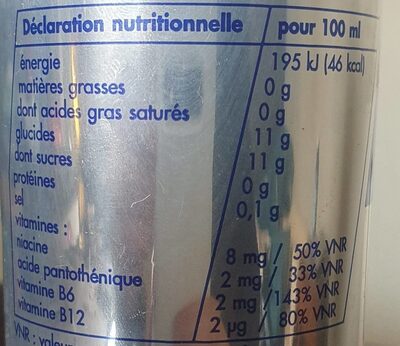Boisson énergisante - Red Bull - 355 ml
This product page is not complete. You can help to complete it by editing it and adding more data from the photos we have, or by taking more photos using the app for Android or iPhone/iPad. Thank you!
×
Barcode: 9002490210717 (EAN / EAN-13)
Common name: Red Bull Energy
Quantity: 355 ml
Packaging: Canette Aluminium
Brands: Red Bull
Categories: Beverages, Energy drinks, Boissons, Boissons avec sucre ajouté, Boissons gazeuses, Boissons sans alcool, Boissons énergisantes
Labels, certifications, awards: Deconseille-aux-enfants, Déconseillé aux enfants et aux femmes enceintes, Déconseillé aux femmes enceintes, Déconseillé à certaines catégories de personnes
Stores: Auchan, carrefour.fr
Countries where sold: France
Matching with your preferences
Report a problem
Data sources
Product added on by lilimarti
Last edit of product page on by openfoodfacts-contributors.
Product page also edited by annelotte, beniben, date-limite-app, driveoff, ecoscore-impact-estimator, halal-app-chakib, hugopeuze, jeanbono, kiliweb, nikezeubi, packbot, stephane, yuka.R29rR0lvSWgrY3NBcS9BRzhCYUYvOHB0OVlha2NuS1NNY0JLSUE9PQ, yuka.RjZ3eUZwaFpvK1FvaGRnYzNrL0ZvZUI2K2J5T1FXT1ROZEk4SVE9PQ, yuka.SDU0L0hKWXUrdGcyeHRvZXBESFZ4OTR0N1lXN1UycnBjUHNUSVE9PQ, yuka.SGFZTExhMGVvUGtQaXZFQTNSelQzb3RLbjhPYmUyaW5CZWNmSVE9PQ, yuka.SHBnbk81czRxdkFEbnNZVC9rclM2UHNyd01DcWVVbnNJcmNSSVE9PQ, yuka.U1k4Q01MczloOE16dy9OanhrTFE5dkZYL1oyMFFYcWFOOFFKSWc9PQ, yuka.U3JBbU01NFBpOFVsc1BReHhoTFYzZjlzMTY2dVJXTzVKYlVKSVE9PQ, yuka.UWJzeEVZc3FyOVlBdFBGayt3cjUzOTl0Njg2RkEzMlREdGN6SVE9PQ, yuka.UXFGWkVaZzduc0ZSdE1VUTd3SDU5ZDU4d2NXeVEzN3BBUGNKSWc9PQ, yuka.UkpoZk1QZ29xTUE2c3M4aStSbjR4KzFhMzd1WVEwQzZOc0VMSWc9PQ, yuka.VzU4cENaWXp1ZWtNeHNVN3IwTDM0dHhLM2IrdkFXNjZJZGhOSUE9PQ, yuka.WXJFUkNxVXhncVFRbnNVTXBrdjV3ODRzeGJpdkJWcWVkZVl2SVE9PQ, yuka.YS9zcE9mb0dvdnRRdWNReTBpM282dnhPOTdHbloxS1BBc3d5SVE9PQ, yuka.YUtsZEQ2TlovZVVSb01ZUDF3cjIwWW9sbThDSGRuNlFjN2MvSUE9PQ, yuka.ZXEwZENZazkrUGc3Z2ZBdzBEUHozdjB1MnM2a2MzanBHc0JQSVE9PQ, yuka.sY2b0xO6T85zoF3NwEKvlkBaXf_h_mL8DTDSq3eIm8e3ELX1bel1v9j8F6s.












